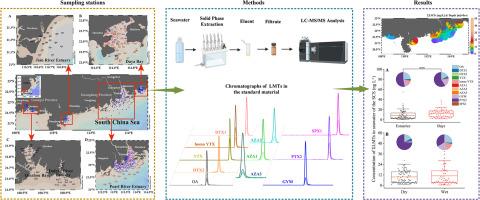南海富营养化沿海水域亲脂藻毒素的季节和区域变异
IF 4.5
1区 生物学
Q1 MARINE & FRESHWATER BIOLOGY
引用次数: 0
摘要
亲脂性海洋藻毒素(lmt)主要由产毒鞭毛藻产生,由于其毒性和广泛分布,对海洋生态系统和人类健康构成重大风险。研究了2022-2023年南海代表性河口湾区表层海水中lmt的时空分布特征。采用活性固相萃取-液相色谱-串联质谱联用技术(active - spe - lc -MS/MS)研究发现,半封闭海湾地区的毒素浓度(13.15±8.61 ng L−1)显著高于河口地区(8.55±8.59 ng L−1),其中大亚湾(DB)和剑江口(JRE)的毒素含量最高。最常见的毒素是腹泻性贝类毒素(OA、DTX1)和果皮毒素-2 (PTX2),大部分地区以PTX2为主。季节变化明显,在雨季,特别是春季和夏季,观察到的LMTs浓度较高。主成分分析显示,珠江口(PRE)以PTX2、GYM和OA为主,而钦州湾(QB)以AZA2和DTX1为主。该研究强调了当地环境条件(如季节和区域变化)对LMTs分布的影响。这些发现为富营养化沿海水域中浮游生物的生态动态提供了重要见解,强调需要持续监测以减轻对海洋生态系统和人类健康的风险。这项研究有助于更深入地了解南中国海的LMTs分布模式,为未来的风险评估和管理策略提供支持。本文章由计算机程序翻译,如有差异,请以英文原文为准。

Seasonal and regional variability of lipophilic marine phycotoxins in eutrophic coastal waters of the South China Sea
Lipophilic marine phycotoxins (LMTs), primarily produced by toxigenic dinoflagellates, pose significant risks to marine ecosystems and human health due to their toxicity and widespread distribution. This study investigates the spatial and temporal distribution of LMTs in the surface seawater from representative estuarine and bay areas of the South China Sea (SCS) during period from 2022‒2023. Using active solid-phase extraction coupled with liquid chromatography-tandem mass spectrometry (Active-SPE-LC-MS/MS), the study revealed that significantly higher LMTs concentrations in semi-enclosed bays (13.15 ± 8.61 ng L−1) compared to estuarine regions (8.55 ± 8.59 ng L−1), with Daya Bay (DB) and Jian River Estuary (JRE) exhibiting the highest toxin levels. The most prevalent toxins were diarrhetic shellfish toxins (OA, DTX1) and pectenotoxin-2 (PTX2), with PTX2 being dominant in most regions. Seasonal variations were evident, with higher LMTs concentrations observed during the wet season, particularly in spring and summer. Principal component analysis (PCA) revealed distinct toxin profiles, with PTX2, GYM, and OA being prevalent in the Pearl River Estuary (PRE), while AZA2 and DTX1 were more abundant in Qinzhou Bay (QB). The study highlights the influence of local environmental conditions, such as seasonal and region variations on LMTs distribution. These findings provide critical insights into the ecological dynamics of LMTs in eutrophic coastal waters, emphasizing the need for continuous monitoring to mitigate risks to marine ecosystems and human health. This research contributes to a deeper understanding of LMTs distribution patterns in the SCS, supporting future risk assessments and management strategies.
求助全文
通过发布文献求助,成功后即可免费获取论文全文。
去求助
来源期刊

Harmful Algae
生物-海洋与淡水生物学
CiteScore
12.50
自引率
15.20%
发文量
122
审稿时长
7.5 months
期刊介绍:
This journal provides a forum to promote knowledge of harmful microalgae and macroalgae, including cyanobacteria, as well as monitoring, management and control of these organisms.
 求助内容:
求助内容: 应助结果提醒方式:
应助结果提醒方式:


